The Main Avenue mini roundabouts that have been a point of contention for some residents and visitors while welcomed by others, are here to stay.
“We are making these roundabouts permanent,” said Stuart Richardson, Alberta Transportation infrastructure manager, during a presentation at the Jan. 7 council meeting.
“Alberta Transportation is making the decision to move ahead with these roundabouts. We’re happy with the way the corridor’s working, and we’re OK with the public impact as well.”
The traffic calming measures are poised to become concrete fixtures in the coming years once Alberta Transportation allocates funding for the Highway 27 overlay project, which involves resurfacing the stretch of road from the Highway 22 intersection east of Sundre to immediately west of town.
Input regarding the mini roundabouts between Second and Fourth streets is being used to help fine-tune plans for the future permanent design, he said.
“We’re going to make some positive improvements with the public’s comments.”
Additionally, Alberta Transportation will continue to collaborate with the municipality, which is developing plans to upgrade aging underground infrastructure.
The intent is to minimize throwaway costs by avoiding ripping up freshly laid road and constructed roundabouts to install pipes below the surface, he said.
The design for the three mini roundabouts was originally selected from several options following consultations with stakeholders as well as the community, and details were developed with the municipality’s engineers, he said.
They were the first to be installed and used in Alberta on a provincial highway corridor, he said.
“Since the Sundre project’s happened, there’s been a lot more in North America going ahead. So it is being used more often now.”
Modular components were used for the initial deployment so “if the roundabouts didn’t work out, we could always go back to the four-lane corridor and try something else.”
Objectives met
While there have been a number of Sundre residents expressing opposition to the mini roundabouts throughout the trial project, Richardson told council that there have not been major complaints filed from industry stakeholders and that the heavy load corridor continues to sustain a reasonable flow of traffic, even on busy weekends.
“This is an important corridor,” said Richardson, adding that accommodating oversized loads is a primary concern and that the situation has been manageable even through the peak season.
“I don’t think it’s anything worse than what’s happened in the past.”
The objectives of reducing the speed of traffic while maintaining flow and improving pedestrian safety have largely been met, he said.
“That buffer zone has been successful. Between the roundabouts, the traffic is quite a distance from the sidewalk now,” he said.
Richardson acknowledged ongoing efforts to determine how to deal with the proximity between the sidewalk and the road on corners where the roundabouts lead vehicles close to the curb.
Mistakes made
He admitted some mistakes were made throughout the pilot project’s deployment and lessons were learned.
“Weather-wise, (it) wasn’t so great leaving it so late in the year,” he said, referring to the initial October and early November 2017 construction period that was hampered by unfavourable conditions and would have benefited from starting in the spring or summer.
“The timing of it was probably one of the worst issues for us.”
Additionally, there was a holdup in getting the components for the roundabouts manufactured in time, he said.
“That was probably the main delay. And as soon as the product was available, we installed it as soon as possible.”
He pointed to other issues including lane markings and the unsuccessful flexi posts, which he called a "disaster."
“The flexi posts, which we thought was a great idea and would bounce back up, lasted a day or something,” he said.
“These are things that we are taking as lessons learned. It didn’t look great at all to the public. We looked like idiots putting these things in and they failed straight away. We’re never going to use them again.”
He said the poor pavement markings that created directional confusion among motorists were another problem. The old design’s lines should have been ground off of the road surface from the beginning instead of covered over with a coat of black paint that quickly wore off, he said.
“We’re going to hopefully get funding for permanent line markings as well.”
Several potholes such as the one at the Third Street intersection have also been a pervasive, recurring problem caused largely by roundabout-guided traffic driving more heavily over areas they previously did not, as well as weathering caused by running water and melting snow, he said.
There were also issues with pedestrians crossing on the circles, even though there are clearly marked pedestrian crossing lanes with signs and more recently installed vertical flashing lights as well, he said.
“It’s not just pushing that button. You can’t just walk out (onto the road), you need to wait until the traffic stops…you still got to wait for that flashing to go and then for the car to see it and then slow down and stop.”
Feedback
Surveys throughout the past year generated “some pretty negative feedback for the most part just on the roundabouts themselves and the education” on how to navigate them, he said.
Some people remain a bit uncertain in instances when multiple vehicles approach an intersection from different directions at the same time, he said.
“The good thing about it is (the roundabouts are) slowing traffic down.”
When in doubt, he said drivers should look for a safe gap in traffic before proceeding.
In terms of maintenance and snow clearing efforts, Richardson praised Sundre’s operations manager Jim Hall and town staff for keeping the roundabouts clear during the winter.
“This wouldn’t work without that,” he said.
“We are just not set up just now for clearing snow in these situations; we don’t have the small machines to clear these. But this has been included in our renewed maintenance contract…so for following years, we should be able to do that.”



